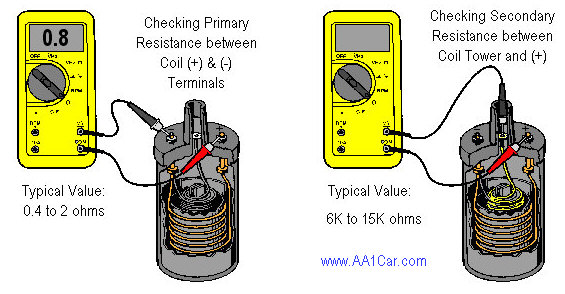To check an ignition coil, start by disconnecting the coil from the car’s electrical system. Then, using a multimeter, measure the resistance between the primary and secondary terminals to determine if it’s within the manufacturer’s specifications.
This will help you identify if the ignition coil is functioning properly or if it needs to be replaced. When your car’s engine misfires or has difficulty starting, it may indicate a faulty ignition coil. Checking the ignition coil’s condition is crucial in maintaining the vehicle’s performance and preventing potential breakdowns.
By following a few simple steps and using a multimeter, you can quickly assess the ignition coil’s health and address any issues accordingly. Regularly inspecting and testing the ignition coil can help ensure the smooth operation of your vehicle’s engine, saving you time and money in the long run.

Credit: m.youtube.com
Importance Of Ignition Coil
The ignition coil is an essential part of a vehicle’s ignition system, responsible for generating the high voltage needed to ignite the fuel and air mixture in the engine. It plays a crucial role in ensuring the smooth and efficient operation of the vehicle.
The function of the ignition coil involves converting the low voltage from the battery into the high voltage required for the spark plugs to ignite the fuel. This conversion is crucial for the engine to run smoothly.
There are several signs that indicate a faulty ignition coil, such as rough idling, misfiring, difficulty starting the engine, and decreased fuel efficiency. If any of these signs are observed, it is important to have the ignition coil checked as soon as possible to prevent further damage to the vehicle.
Credit: www.autozone.com
Tools Required
- Multimeter
- Flathead Screwdriver
Steps To Check Ignition Coil
Locate the Ignition Coil: Start by identifying the location of the ignition coil in your vehicle.
Disconnect Coil from Spark Plug: Carefully disconnect the coil from the spark plug by removing the wire.
Use Multimeter to Test Coil: Set your multimeter to the ohms setting and then connect the probes to the terminals of the ignition coil. Check the reading on the multimeter to determine if the ignition coil is functioning properly.
Interpreting Results
Normal readings when checking an ignition coil typically range between 0.4 to 2 ohms. This indicates that the coil is functioning properly and within the acceptable range. If the resistance is too high or too low, it may suggest a faulty coil that needs to be replaced.
Abnormal readings can occur in different scenarios. High resistance above 2 ohms could be caused by a damaged coil winding or a faulty secondary winding. On the other hand, low resistance below 0.4 ohms may suggest a short circuit within the coil or a failure of the primary winding.
It’s important to mention that these readings may vary depending on the specific ignition coil and manufacturer’s specifications. Always consult the manufacturer’s guidelines and compare the readings obtained to the recommended range to ensure accurate diagnostics and troubleshooting.
Replacing Ignition Coil
To determine if the ignition coil needs replacement, conduct a simple multimeter test. Measure resistance levels to ensure proper functioning. Replacing a faulty ignition coil promptly can improve engine performance and prevent potential breakdowns.
| Step 1: Carefully remove old coil to avoid damage. |
| Step 2: Choose a new ignition coil that matches your vehicle’s specs. |
| Step 3: Install the new coil, ensuring proper connection and fit. |
| Step 4: Test the ignition system to verify successful replacement. |

Credit: www.studebaker-info.org
Frequently Asked Questions For How To Check An Ignition Coil
How Can You Tell If An Ignition Coil Is Bad?
If your ignition coil is bad, you may experience problems like misfiring, difficulty starting the engine, or a decrease in power and fuel efficiency. Other signs include a rough idle, stalling, and a check engine light. Regular maintenance and inspection can help detect and resolve ignition coil issues.
How Do You Test An Ignition Coil With A Multimeter?
To test an ignition coil with a multimeter, set the multimeter to the ohms setting. Attach the positive and negative leads to the corresponding terminals on the ignition coil. Check the reading on the multimeter. A healthy coil will typically read between 0.
4 to 2 ohms.
How Do I Know I Need To Replace Ignition Coil?
If your car has difficulty starting or runs rough, it may be time to replace the ignition coil. Look for symptoms such as engine misfires or stalling. Regular maintenance can help prevent issues.
How Many Ohms Should A Ignition Coil Have?
The ignition coil should have a specific resistance value in ohms, typically between 0. 2 and 2. 5 ohms. This resistance ensures proper functioning of the coil and the ignition system overall.
Conclusion
To sum up, checking an ignition coil is a straightforward process that can help diagnose issues with your vehicle’s ignition system. By following the step-by-step guide outlined in this blog post, you can easily determine whether your ignition coil is working properly or if it needs to be replaced.
Remember, regular maintenance and inspections are key to ensuring your vehicle runs smoothly and efficiently. So, don’t overlook the importance of checking your ignition coil regularly for optimal performance.
{ “@context”: “https://schema.org”, “@type”: “FAQPage”, “mainEntity”: [ { “@type”: “Question”, “name”: “How can you tell if an ignition coil is bad?”, “acceptedAnswer”: { “@type”: “Answer”, “text”: “If your ignition coil is bad, you may experience problems like misfiring, difficulty starting the engine, or a decrease in power and fuel efficiency. Other signs include a rough idle, stalling, and a check engine light. Regular maintenance and inspection can help detect and resolve ignition coil issues.” } } , { “@type”: “Question”, “name”: “How do you test an ignition coil with a multimeter?”, “acceptedAnswer”: { “@type”: “Answer”, “text”: “To test an ignition coil with a multimeter, set the multimeter to the ohms setting. Attach the positive and negative leads to the corresponding terminals on the ignition coil. Check the reading on the multimeter. A healthy coil will typically read between 0.4 to 2 ohms.” } } , { “@type”: “Question”, “name”: “How do I know I need to replace ignition coil?”, “acceptedAnswer”: { “@type”: “Answer”, “text”: “If your car has difficulty starting or runs rough, it may be time to replace the ignition coil. Look for symptoms such as engine misfires or stalling. Regular maintenance can help prevent issues.” } } , { “@type”: “Question”, “name”: “How many ohms should a ignition coil have?”, “acceptedAnswer”: { “@type”: “Answer”, “text”: “The ignition coil should have a specific resistance value in ohms, typically between 0.2 and 2.5 ohms. This resistance ensures proper functioning of the coil and the ignition system overall.” } } ] }
